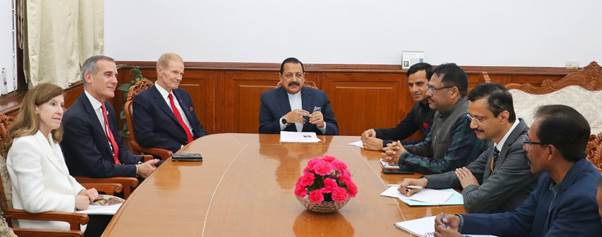India and the United States are set to collaborate on the launch of a joint remote sensing satellite in the first quarter of the next year, Union Minister Jitendra Singh said in statement after meeting a high-level delegation from NASA, led by its chief, Bill Nelson, in New Delhi.
The collaborative satellite, named NASA-ISRO Synthetic Aperture Radar (NISAR), is slated for launch aboard India’s GSLV (Geosynchronous Satellite Launch Vehicle). It will help enhance Earth observation capabilities with a focus on studying diverse aspects such as land ecosystems, solid earth deformation, polar cryosphere, sea ice, and coastal oceans.
During the meeting, Nelson extended congratulations to the Union Minister for the historic Chandrayaan-3 landing on the untouched South Polar region of the Moon. Furthermore, he urged an acceleration of programs related to India’s first astronaut aboard a NASA rocket to the International Space Station (ISS).
Earlier this year, during Prime Minister Narendra Modi’s visit to the US, both nations agreed to embark on a two-week joint India-US space flight next year. NASA is actively exploring opportunities in the Private Astronaut Mission for Indian astronauts scheduled for 2024.
Collaboration between ISRO and NASA has led to the formation of a Joint Working Group (JWG) on human spaceflight cooperation. The 8th meeting of the India-USA Joint Working Group on Civil Space Cooperation (CSJWG) held in Washington DC in January 2023 emphasized the commitment to enhancing bilateral space cooperation.
ISRO, in conjunction with the Department of Space (DoS), is engaged in discussions with US companies such as Boeing, Blue Origin, and Voyager to explore specific avenues of cooperation. Simultaneously, collaborations with Indian commercial entities are also being explored.
Ongoing dialogue between ISRO and NASA has resulted in the development of a concept paper on the Implementing Arrangement (IA), currently under consideration. After mutual iterations, both entities have reached a consensus, and the document is now in the process of obtaining intra-governmental approvals.
ISRO is also exploring the feasibility of utilizing NASA’s Hypervelocity Impact Test (HVIT) facility for testing the Gaganyaan module’s Micrometeoroid and Orbital Debris (MMOD) protection shields.
In discussions with the U.S. delegation, Singh highlighted India’s thriving space sector startups, noting that in just about four years, the number of space startups has surged from single digits to over 150, with several evolving into prosperous ventures.
Nelson, a seasoned astronaut who flew with the crew of the 24th Space Shuttle flight onboard ‘Columbia’ in 1986, commended ISRO for successfully launching 231 satellites from the US aboard the Polar Satellite Launch Vehicle (PSLV).














